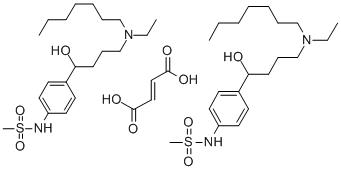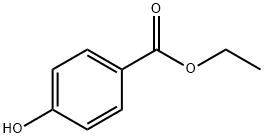IbutilideFumarate , 98% , 122647-32-9
Synonym(s):
(±)-N-[4-[4-(Ethylheptylamino)-1-hydroxybutyl]phenyl]-methanesulfonamide hemifumarate salt;Corvert;Ibutilide hemifumarate salt
CAS NO.:122647-32-9
Empirical Formula: (C20H36N2O3S)2.C4H4O4
Molecular Weight: 885.24
MDL number: MFCD01715410
EINECS: 687-381-2
| Pack Size | Price | Stock | Quantity |
| 100mg | RMB572.00 | In Stock |
|
| 250mg | RMB857.60 | In Stock |
|
| 1g | RMB2144.00 | In Stock |
|
| others | Enquire |
PRODUCT Properties
| Melting point: | 112-117?C |
| RTECS | PB0475700 |
| storage temp. | 2-8°C |
| solubility | H2O: >20mg/mL |
| form | solid |
| color | off-white to tan |
| Water Solubility | H2O: >20mg/mL |
| λmax | 267nm(EtOH)(lit.) |
| Merck | 14,4883 |
| CAS DataBase Reference | 122647-32-9(CAS DataBase Reference) |
Description and Uses
Covert was launched in the US and UK for treatment of atrial fibrillation and flutter and can be synthesized in three steps from N-phenyl rnethanesulfonamide. While ibutilide has an asymmetric center, it has been determined that the racemate is equipotent with either enantiomer. The antiarrhythmic action is derived from the compounds ability to prolong the action potential duration and lengthen the refractory period of myocardial tissue. Class Ⅲ antiarrhythrnic agents accomplish this by blocking outward potassium channels, however, ibutilide elicits the same effect by activation of slow inward sodium channels. Recent evidence indicates that it also is a potent blocker of the rapidly acting delayed rectifier potassium current (lkr)and may block the ATP-inhibited potassium channel.
A methanesulfonanilide antiarrhythmic agent; prologns myocardial action potential duration, predominantly by activation of slow inward sodium current. Antiarrhythmic (class III).
Safety
| Symbol(GHS) |   GHS07,GHS08 |
| Signal word | Warning |
| Hazard statements | H302-H361d |
| Precautionary statements | P202-P264-P270-P280-P301+P312-P308+P313 |
| Hazard Codes | Xn |
| Risk Statements | 22 |
| WGK Germany | 1 |
| HS Code | 2935904000 |
| Toxicity | rat,LD,oral,> 500mg/kg (500mg/kg),Teratology, The International Journal of Abnormal Development. Vol. 49, Pg. 406, 1994. |




